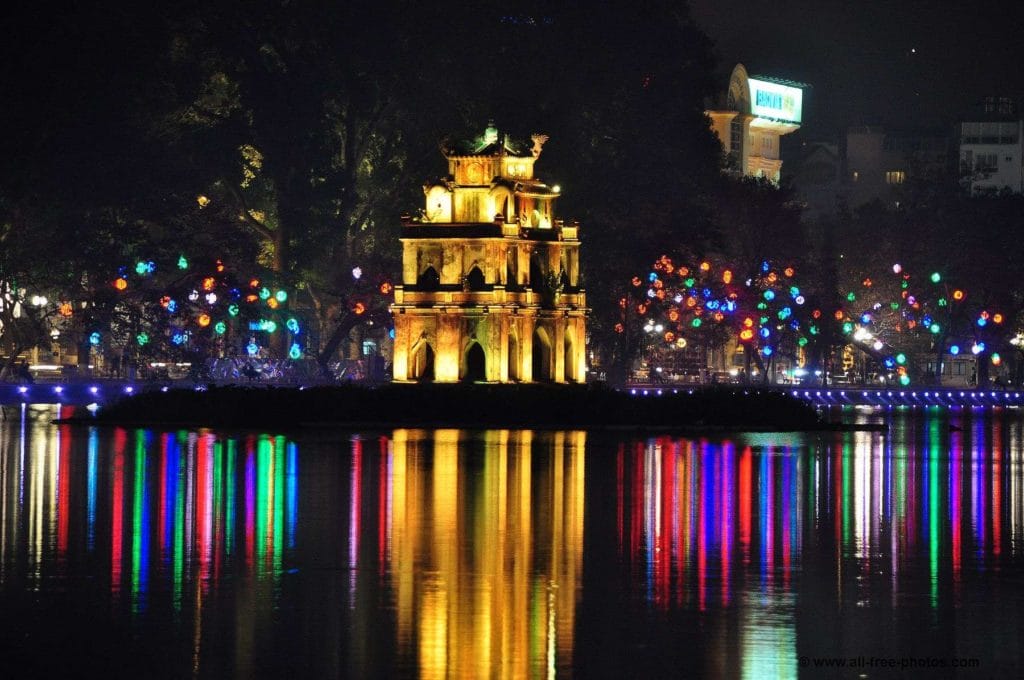Ha Noi is the capital of Socialist Republic of Vietnam. Ha Noi lies in Red River Delta and is situated in a tropical area having a strong monsoon influence. The name of Ha Noi (Interior side of a river) has been derived from an ancient language which is literally known as a land area located in the inner side of Red River. It does not mean that the city is inside the river, but it is embraced by about 100 km of the Red River dykes. Ha Noi has seven inner precincts (Hoan Kiem, Ba Dinh, Hai Ba Trung, Dong Da, Cau Giay, Tay Ho, Thanh Xuan) and five suburban districts (Tu Liem, Thanh Tri, Gia Lam,Dong Anh and Soc Son).
From the time when the first State of ancient Vietnam was established , Ha Noi (formerly Thang Long) has been considered a sacred and typical part of Vietnam. It was in the autumn of 1010 that Lý Cong Uan (also known as Lý Thai To) – the founder of Nha Hau Lý (Post-Ly Dynasty) – removed the court from Hoa Loa (present-day Ninh Binh province) to Dai La Citadel which was later renamed as Thang Long . As soon as the royal fleet with King Lý Thai To aboard cast anchors at the landing wharf in the Nhue River (present-day Red River) , there ascended a golden dragon. Thinking that it was a good omen for his trip, King Lý Thai To had Dai La Citadel renamed Thang Long (Ascending Dragon) .
He also had Hoa Lu – his former capital – renamed Truong Yen. 1397 was the year marking an end to the decline of Nha Hau Le (Post-Le Dynasty). It was the time when the king indulged himself in entertainments. Ho Quý Ly, a high-ranking court official, overthrew the king and proclaimed himself the king of a new dynasty – Ho Dynasty. This dynasty removed the court to Tay Do(Western Capital) in Thanh Ho¸ province.

Thang Long was then renamed Dong Do(Eastern Capital). In 1407, the Ming aggressors defeated the army of Ho Dynasty. They rushed to Dong Do Citadel and renamed it Dong Quan Citadel. In 1418, a farmer whose name was Le Loi (future Le Thai To) grouped an insurrection army in Lam Son district in Thanh Hoa province. He proclaimed himself as BinhDinh Vuong (King of Pacification) and led the resistance against the aggressors for 10 years and regained national independence.
He entered the then Dong Quan Citadel and the next year, he renamed the citadel as Dong Kinh (Eastern Imperial City). In 1527, when a new dynasty – Nha Mac (Mac Dynasty) – was in the control of the country, the citadel resumed its former name (Thang Long). In 1802, King Gia Long established the first court of Nha Nguyen (Nguyen Dynasty) in Phu Xuan in the central coastal city of Hue. Thang Long was then used as the regional capital exercising influence on 11 northern citadels. But the word LONG which literally meant RONG (Dragon) was changed to LONG which was understood as THINH (Prosperity).
In 1831, King Minh Mang established the province of Ha Noi which includes the ancient Thang Long Citadel and the districts of Tu Liem, Ung Hoa, Thuong Tin and Lý Nhan .In 1888, after the tragic defeat of Nha Nguyen (Nguyen Dynasty), Ha Noi became a colonial city until 1954. On September 2, 1954, President HoChi Minh read the Declaration of Independence and formally established the first government of the young republic – Democratic Republic of Vietnam. Ha Noi was then formally declared the capital of Vietnam. Ha Noi capital was liberated from French colonialists on October 10, 1954.
After the complete victory on April 30, 1975 and the reunification of the country the next year, Ha Noi was officially recognized as the capital of Socialist Republic of Vietnam. In the old days, each of 36 guild streets in Ha Noi had its name closely associated with the trade and occupation of the inhabitants. Now, Ha Noi has 381 streets representing a tenfold increase as compared with the ancient Ha Noi with 36 guild streets only.
